Top News
April 21, 2016 Ryukyu Shimpo
The Okinawa Prefectural Government (OPG) announced that visitor arrivals in 2015 reached 7,936,300, which is a 10.7 percent increase from the previous year. This is a new record. Foreign visitors increased by 69.4 percent, reaching 1,670,300. Expansion in airline routes as well as an increase in cruise ships contributed to the drastic increase. Due to typhoons in the summer, domestic visitors remained at 6,266,000, 1.3 percent increase from the previous year.
The breakdown of the figures on foreign visitors shows Taiwanese tourists as 505,400, increasing by 39.5 percent. This is the first time that the number of Taiwanese tourists has reached 0.5 million. The number of tourists coming from the Chinese mainland was 354,800, 2.7 times the figure in 2014. 332,800 visitors arrived from Korea, which is a 73.6 percent increase. The number of Okinawa-bound tourists, recorded by both countries, is the first over 0.3 million. Hong Kong reached 0.2 million tourists for the first time, with 201,900 visitors. This number is an increase of 46.8 percent on the previous year.
Domestic tourists from Tokyo increased by 0.4 percent reaching 3,057,000; Kansai by 4.6 percent with 1,320,700; Fukuoka by 6.2 percent with 788,000; Nagoya by 2.1 percent with 497,200; and
At the same time, the visitor arrivals in March increased by 7.6 percent with 709,200 visitors, reaching 0.7 million in March for the first time. Domestic visitor numbers for March decreased by 1.5 percent with 571,300, while international visits increased by 74.6 percent with 137,900. This is the 42nd consecutive month in which tourist numbers have been higher than the same month in the previous year. Tourist number records have reached new records for 29 consecutive months.
Mitsuyuki Maeda of the OPG said the government anticipates continued growth for 2016, “the growth of visitors will continue to do well.”
(English translation by T&CT and Sayaka Sakuma)
Go to Japanese
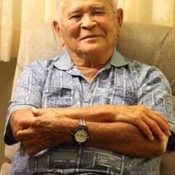
April 25, 2016 Ryukyu Shimpo
By Hanae Higa Gushiken
This January, Mac Masayuki Yonamine (Nishihara Chojin Kai of Hawaii United Okinawa Association) turned 88 years old. Last year, Yonamine made donations to the Hawaii Okinawa Center towards the installation of an elevator and for the construction of a resource center in the future. In 2013, Yonamine helped find a final resting place for Katsu Ishiki, an Okinawan Issei (first generation immigrant), whose unclaimed remains were stored in a vault for many years at the Oahu Cemetery. After conducting a Buddhist memorial service, Katsu was finally able to rest in peace. Yonamine’s selfless contributions to the Uchinanchu (Okinawan) community have caught the attention of local newspapers. We interviewed Yonamine to ask him what the Uchinanchu Community means to him.
― Please tell us about your family.
“I was born in Maui Island in 1928. My father is Taro Yonamine and my mother is Ushi Yonamine (maiden name: Takushi). They are both from Kouchi, Nishihara Town. I was their second child. In 1905, my grandfather, Jiro Yonamine migrated to Maui Island, followed by my grandmother, aunt, and father, who was 12 or 13 years old at the time they migrated in 1913. They worked on a pineapple farm. In 1918, my father married my mother Ushi who was around 17 or 18 years old and living in Okinawa at the time. They were blessed with five children.”
― What was your childhood like?
“My parents were very hard-working. When I didn’t have school, I had to do chores on the farm. Working on the farm was so rough that I even remember thinking to myself, ‘I’d rather die than continue working like this.’”
“My parents weren’t drinkers at all, but they knew how to make sake. My mother would make sake, using potatoes and sold them off for a dollar per gallon (around 3.8 liters). Considering that working on the farm made a dollar per day, this was very good business. Many Uchina (Okinawan) women would make and sell sake, trying to supplement the household income.”
“I remember my parents would often tell me in Uchinaaguchi, ‘we all want a lot of things, but there’s very little that we actually need.’”
― I heard your wife also has Okinawan roots as well?
“My wife Patsy is an Okinawan Nisei (second generation immigrant) and her maiden name was Arakaki. I couldn’t imagine marrying someone who wasn’t an Uchinanchu. She had to be an Uchinanchu, not even a Japanese American. That way she would be able to speak Uchinanchu with my parents who don’t speak English. We were both teachers. Although we were not blessed with any children, we had many relatives around, including our nieces and nephews.”
― Are you looking forward to the Worldwide Uchinanchu Festival this October?
“We visit Okinawa almost every year and always look forward to participating in the Worldwide Uchinanchu Festival. Twenty years ago, when we’d come back to Okinawa, you’d always hear people speaking in Uchinaguchi. But recently, we hear lots of Chinese and it’s become difficult to find someone who seems like an Uchinanchu. I feel a bit sad, but I’m sure it’s a sign that Okinawa is developing.”
― What does the Uchinanchu Community in Hawaii mean to you?
“The Hawaii United Okinawa Association began with Issei Okinawans. In order to keep passing the baton down to the fourth, fifth, and sixth generations, it is essential for each Sonjin Kai and Chojin Kai to work together in solidarity. We provide financial assistance to young Uchinanchu from Hawaii, visiting Okinawa for the first time. We want to keep encouraging them to visit Okinawa. “
(Translation by T&CT, Kaya Doi)
Go to Japanese
April 6, 2016 Ryukyu Shimpo
On April 25, at a public hall in Ginowan, the Aza-Ginowan Hometown Association (chaired by Seiichi Miyagi) unveiled its completed DVD, Images of the Village before the Battle, about Ginowan prior to the Battle of Okinawa. The Association made this DVD with the purpose of proving that a village in Aza-Ginowan existed before the Battle of Okinawa where Futenma Air Station stands today, to counter the argument that there was nothing in the place where Futenma was established. The DVD provides three-dimensional renderings of the buildings and a comprehensive introduction of the culture of the village prior to the Battle, and aims to pass on the village’s history and traditions to coming generations. The Association plans to distribute the DVD among its own members, residents of Ginowan City, and public institutions.
The basis of the DVD project was information verbally gathered by Association members. By examining and comparing U.S. Armed Forces aerial photographs of the area taken in 1945 and today, it is clear that the position of the village in 1945 is presently within Futenma Air Station. The film begins with introductions of Aza-Ginowan’s history, of its horseback riding grounds that are the most expansive in Okinawa, and of Machi-gwaa market for agricultural and marine products.
Chairman Miyagi of the Association said that the film “verifies that present-day Futenma Air Station contains our native home.” He went on to say, “Even students believe that ‘there was nothing’ [where Futenma now stands], but I want people to know that is not true.”
(English translation by T&CT and Erin Jones)
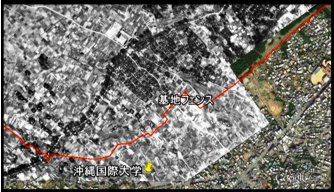
In Images of the Village before the Battle made by Aza-Ginowan Hometown Association, it can be seen that the village existed where Futenma Air Station now stands.
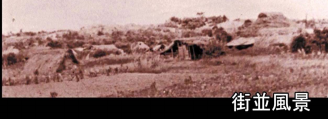
An image of the village (from Images of the Village before the Battle)
Go to Japanese
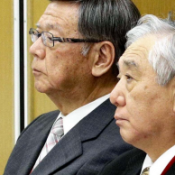
April 23, 2016 Ryukyu Shimpo
On April 22, at the Ministry of Local Affairs and Communications, the Committee for Settling National-Local Disputes held its third meeting regarding the U.S. Marine Corps Air Station Futenma relocation issue. Last year, Okinawan Governor Takeshi Onaga rescinded the permit authorizing reclamation of land in Henoko, Nago in order to build new facility to replace Futenma. In response, Japan’s Minister of Land, Infrastructure, Transport and Tourism (MLITT), Keiichi Ishii, submitted a rectification order demanding that Onaga reinstate the permit. The Committee is reviewing whether the MLITT’s order was appropriate.
Representatives from both the Okinawa prefectural government and the Japanese national government made statements at the April 22 meeting. Representing Okinawa, Governor Onaga stated he fears the reclamation of land in Henoko will be remembered by future generations as an egregious act of folly that caused a treasure with value to all of humanity to vanish from the face of the earth. Meanwhile, national government representatives argued that there were no legal flaws in the land reclamation authorization, and even if flaws were to exist, rescinding the authorization would still not be permitted from the standpoint of protecting trust among the related parties. After hearing from both sides, the Committee discussed in private and decided to send written questions to the two parties. The Okinawa prefectural government has requested that Nago Mayor Susumu Inamine be allowed to testify before the Committee as well, and it will discuss whether or not to grant this request at a future meeting.
At the meeting, the two sides disagreed on three main points: (1) Whether national defense and diplomatic decisions can fall within the purview of a review of the interpretation of the Public Waters Reclamation Law; (2) The advantages and disadvantages incurred by authorizing the land reclamation and by rescinding said authorization; and (3) Whether there were legal flaws in the original request for authorization to reclaim land.
In his statement, Governor Onaga referenced the historical background in which Okinawan land was seized using bayonets and bulldozers, and discussed the importance of conserving the rich national environment in Oura Bay. He pointed to the fact that the land reclamation authorization by former Governor Hirokazu Nakaima did not meet the requirements stipulated in the Public Waters Reclamation Law. “Building a new, permanent military base in Okinawa means perpetuating the disproportionate burden and damage inflicted upon Okinawa due to the concentration of U.S. military bases,” Onaga said.
Representing the MLITT, Ministry of Justice Litigation Bureau Chief Makoto Jozuka told the Committee that Governor Onaga’s rescinding of the permit was an illegal overreach and abuse of his discretionary power. Jozuka explained that rescinding the permit will have a significant negative impact. He asserted that the Henoko relocation plan is highly rational from the perspective of maintaining the U.S.-Japan alliance, explaining that the former governor’s authorization of the land reclamation permit enabled the U.S. Congress to unfreeze the budget allocated to moving some of the U.S. Marines in Okinawa to Guam.
The Committee has requested that the Okinawa prefectural government submit a response to its written questions by May 2. After it receives Okinawa’s response, it will submit written questions to the MLITT, requesting a response by May 9.
(English translation by T&CT and Sandi Aritza)
Go to Japanese
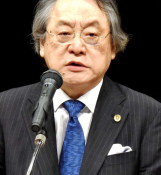
April 21, 2016 Ryukyu Shimpo
On April 20, the All-Okinawa Naha Association to Realize the Aims of the Kempakusho and Pave the Way to the Future held a fiscal 2016 general meeting and a speaking event at the Palette Civic Theater in Naha. Keio University Professor Emeritus Setsu Kobayashi spoke at the event, saying that the construction of a new base in Henoko is a flagrant violation of the Japanese constitution. According to organizer estimates, around 430 people attended the event.
Article 95 of the Japanese constitution stipulates that no special law or act applicable to only one locality may be established unless it is accepted in a local referendum. Referring to this stipulation, Kobayashi stated, “Permission from local residents is needed for the government to place a burden on a specific locality for the sake of national policy. In other words, [local residents] have veto power. The government tries to claim that Article 95 is not relevant to the discussion, but actually, if we consider the spirit of Article 95, this is very much a constitutional issue.”
In his discussion of Japan’s opposition parties joining forces in the upcoming elections, Kobayashi emphasized that the success of the “All-Okinawa” movement has inspired and encouraged people all over Japan.
“The Abe administration has taken away our freedom. Democracy in which debate is suppressed is not democracy at all. We can win. Let’s build a fair and happy future for our children,” Kobayashi stated.
Okinawan Governor Takeshi Onaga also spoke at the event. “I’m very glad that we will continue to be able to engage with strength going forward. If all of us in Okinawa put our strength together, we can break down any wall,” Onaga said.
At the All-Okinawa Naha Association’s first general meeting, held before the event, members reappointed fiscal 2015’s seven co-representatives, including Naha Mayor Mikiko Shiroma.
(English translation by T&CT and Sandi Aritza)
Go to Japanese
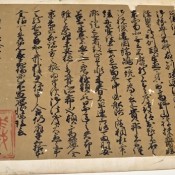
April 17, 2016 Ryukyu Shimpo
On April 16, Satoru Kuroshima, an associate professor of History from the Historiographical Institute, the University of Tokyo, visited a family in Ehime to examine a preserved letter that was sent from Yoshihisa Shimazu, a Satsuma warlord, to Sho Nei, king of the Ryukyu Kingdom. Kuroshima confirmed that the letter was the original.
Kenzen Uehara, an emeritus professor at Okayama University, went along with Kuroshima.
In light of the discovery, Kuroshima speculates that the two letters preserved in the Okinawa Prefectural Archives and the Okinawa Prefectural Museum were copied from a reprint of ancient documents published in 1889.
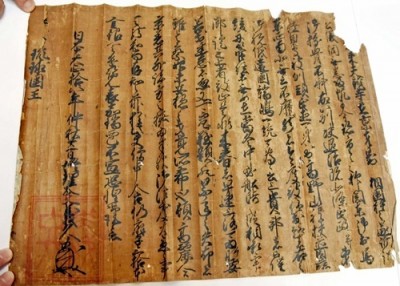
The original letter was found in Ehime Prefecture.
Kuroshima said, referring to the discovery of the original letter hidden for 130 years, “This is the second original document on foreign policy in the Toyotomi administration. We will be able to carry out a scientific analysis from ink and paper used for the letter.”
(English translation by T&CT)
April 13, 2016 Ryukyu Shimpo
On April 13, a letter sent from Yoshihisa Shimazu, a Satsuma warlord, to Sho Nei, king of the Ryukyu Kingdom was discovered in an old house in Iyo City, Ehime Prefecture , according to Kyodo News. The letter was a request to send envoys, celebrating Hideyoshi Toyotomi’s subjugation of the Kanto region.
The letter is known as the 1950 “Shimounake County Public Office Preserved Document” (Ancient documents related to Ehime Prefecture from the Meiji Era) and copies of it have been confirmed. Satoru Kuroshima, an associate professor of History from the Historiographical Institute, the University of Tokyo believes that this is the original letter because it bears Yoshihisa’s stylized signature.
The letter is about 33 cm long and 45 cm wide. In the same year this letter was written, Hideyoshi defeated Hojo and dominated the whole country. To seal the Satsuma victory, Hideyoshi sent a letter requesting envoys to be sent to Kyoto as soon as possible. The letter is written in an oppressive tone, warning that there would be consequences if the Ryukyu king failed to oblige.
(Translation by T&CT, Kaya Doi)
Go to Japanese
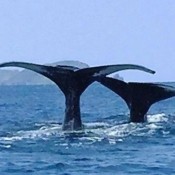
April 20, 2016 Ryukyu Shimpo
By Hideaki Yoneda
Yuriko Nishiura, the manager of a local diving shop in Tokashiki Village, managed to snap a photograph of humpback whales breeding under the water. She saw the whale couple moving their tail fins. Nishiura said, “I managed to catch a rare moment of two whales intimately lining up and diving together.” She went to on to say, “I came across two whales in the offing of Hanari Island while guiding my customers. I was fortunate to get a photograph of the two whales.”
(English translation by T&CT)
Go to Japanese
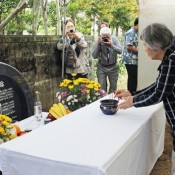
April 20, 2016 Ryukyu Shimpo
On April 12, an unveiling ceremony was held at the Yunapachiku Shelter in Ie Village where a monument was created to commemorate a forced mass suicide that occurred during the Battle of Okinawa. About 30 people including Mayor Hideyuki Shimabukuro and 80-year-old survivor Chieko Namizato offered incense sticks and made a silent prayer for the war dead.
Quoting from Namizato’s book, the inscription on the monument says, “A tragedy in which about 80 civilians, who were backed into a corner, committed mass suicide with a grenade given to them by the Japanese military.”
In line with Namizato’s wishes, the Village built the monument in March to preserve the memory of the Yunapachiku Shelter tragedy and the miseries of war, and to make an oath against war.
The Japanese military excavated about 15-meters deep and 50-meters long tunnel to build the shelter.
Mayor Shimabukuro said, “It is a sad fact that more than 80 people lost their lives at this place. We should not forget it. We would like to use this monument as a symbol of our aspiration to create a world of peace.”
Recalling the scene in the shelter, Namizato, who was nine years old at that time, could not hold back her tears during the ceremony.
Regarding the building of the monument, she said, “I am overwhelmed with gratitude. I will live long and keep telling the story of the misery of war.” Following the ceremony, she further said, “My wish came true at 80-years-old. I want to tell my family in heaven to rest in peace.”
(English translation by T&CT and Megumi Chibana)
Go to Japanese
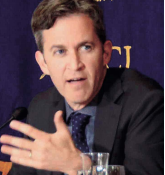
April 20, 2016 Ryukyu Shimpo
David Kaye, the UN Special Rapporteur on the promotion and protection of the right to freedom of opinion and expression, visited Japan to research how the Japanese government has been handling its citizens’ freedom of expression. Kaye held a press conference at the Foreign Correspondents’ Club of Japan in Tokyo on April 19. Kay said he had reported concerns to the Japanese government about a crackdown on protesters opposing the construction of a new U.S. military base in Henoko, Nago.
After hearing reports of excessive force being used by the police and the coast guard against the citizens’ nonviolent protest, Kaye decided to report his concerns to the Japanese government. He also expressed his concerns over hate speech against citizens opposing U.S. military bases in Okinawa and Japanese politicians’ pressure on two Okinawan newspapers. Kaye stated the situation was very serious and said he would continue to research the matter further and report concerns to the Japanese government.
Kaye said that he had personally researched the crackdown on protesters opposing the construction of the new military base in Henoko. He said that he had heard about the excessive security blocking the citizens’ nonviolent protest in Henoko and said he would continue to pursue the issues.
(English translation by T&CT)
Go to Japanese
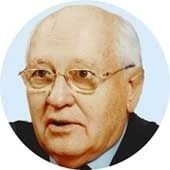
April 22, 2016 Ryukyu Shimpo
The Ryukyu Shimpo has received a letter from Mikhail Gorbachev, the last leader of the Soviet Union who led to the end of the Cold War and won the Nobel Peace Prize. In his letter, Gorbachev encourages Okinawan people to resist against militarization. His letter to Okinawan citizens marks 15 years since he first visited Okinawa.
Gorbachev wrote, “But today, to my great regret, we again are speaking about growing instability, terrorism, about military conflicts, militarization and arms race. The world did not take the chance given to all of us after the end of the Cold War. ”
“That is why I welcome the struggle of Okinawan citizens for peace, against militarization of the Island, and for the transformation of Okinawa into an even more attractive place for Japanese and foreign tourists from around the world,” he stressed.
The letter refers to his visit to Okinawa: “I had just turned 85 years old. This is a solid age. I often recall the long-livers of your Island and I’m trying to follow their example (drinking tea with goya, for example).”
“Every day when I come to my office my mood lifts when I see the photo taken many years ago in Naha City.”
Gorbachev visited Okinawa in November 2001, invited by the Naha city government commemorating the 80th anniversary of its municipal system. He gave a lecture titled “Peace and Stability in the 21 Century”.
He has visited Okinawa three times. He also gave a lecture at the Ryukyu Forum hosted by the Ryukyu Shimpo.
(English translation by T&CT)
Go to Japanese
The full text of the letter is below:
Dear citizens of Okinawa, Dear Governor Onaga,
Dear president Tomita and journalists of The Ryukyu Shimpo,
15 years passed since I first visited your wonderful Island. I and my colleagues fondly remember that very first visit and of course all trips that followed. In general, I was particularly impressed by the meetings with citizens of Okinawa. We learnt a lot of interesting facts about your rich history and culture. As the founder of The Green Cross International, I highly appreciate and welcome your activities to preserve environment.
I remember the theme of my lecture during that first visit – “Peace and Stability in the 21 Century”. At that time all of us were full of hopes that we would be able to come to a new secure and prosperous world. But today, to my great regret, we again are speaking about growing instability, terrorism, about military conflicts, militarization and arms race. The world did not take the chance given to all of us after the end of the Cold War. That is why I welcome the struggle of the Okinawan citizens for peace, against militarization of the Island,and for the transformation of Okinawa into an even more attractive place for Japanese and foreign tourists from around the world.
I had just turned 85 years old. This is a solid age. I often recall the long-livers of your Island and I’m trying to follow their example (drinking tea with goya, for example). Every day when I come to my office my mood lifts when I see the photo taken many years ago in Naha City. The photo shows a small girl musician in national clothes in my arms. I consider it as a symbol of intergenerational ties. Using this opportunity, I convey greetings and best wishes to this girl and in her person to all Okinawan citizens.
Sincerely yours, Mikhail Gorbachev
April 5, 2016
Go to Japanese











 Webcam(Kokusai Street)
Webcam(Kokusai Street)


